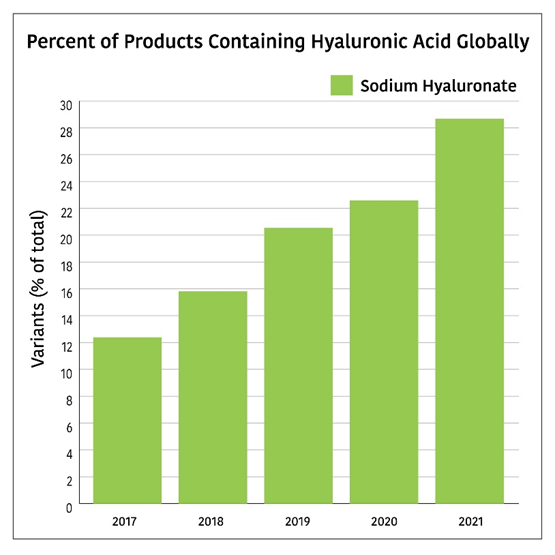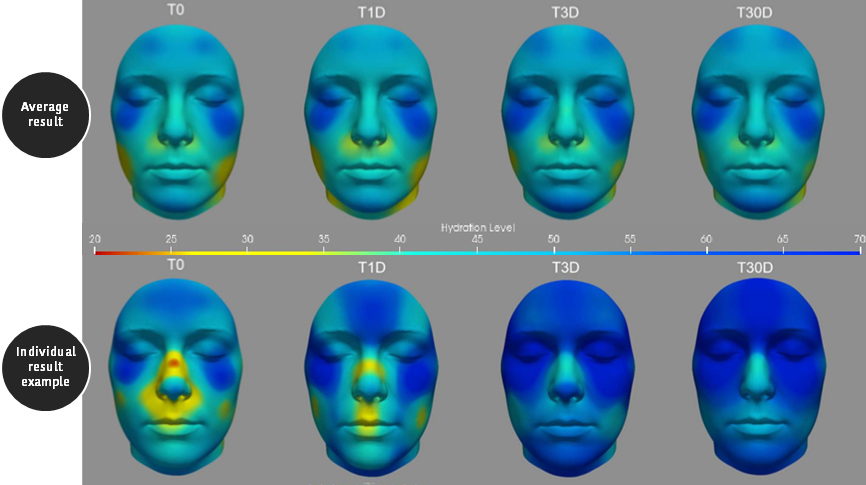Arguably one of the most buzz-worthy ingredients out there, hyaluronic acid is making its way from facial skincare to color cosmetics to body care to hair care. In fact, hyaluronic acid is often recommended by estheticians, dermatologists, and even cosmetic formulators alike for its ability to hydrate, plump, and enhance the skin’s natural glow. However, this hero ingredient, while incredibly common nowadays, is actually quite complex. As a result, it can be a big challenge for formulators and product developers to navigate various hyaluronic acid offerings that will best appeal to their consumers.
What is Hyaluronic Acid?
Hyaluronic acid is a naturally occurring polyanionic polysaccharide. It plays a key role in protecting and stabilizing the skin at the cellular level. Hyaluronic acid is also a natural substance found in the body, specifically within the eyes, joints, and of course organs, like the skin! Much like a well-oiled machine, hyaluronic acid works in the body to keep things hydrated, flexible, and allow range of motion. In the personal care industry, hyaluronic acid is well-known as a powerful humectant. In whatever application, hyaluronic acid can retain up to 1000x its weight in water. Just like a sponge in a sink of water, hyaluronic acid seeks out water in its environment to bind to and soak up. Additionally, hyaluronic acid is a key component of the skin’s natural hydration, and it is something that naturally depletes in the body as aging occurs. These signs of aging, especially in the early stages, can appear from consistently dehydrated skin, and this is where topically applied hyaluronic acid comes in! Due to its excellent film forming properties, hyaluronic acid improves elasticity, reduces inflammation, regenerates the skin barrier, and of course, plumps for younger, healthier looking skin.
Outlining Different Forms of Hyaluronic Acid
It’s no surprise that hyaluronic acid is a trending ingredient. In fact, the use of the hero humectant in formulation is growing globally.
In general, most formulations may use a singular form of hyaluronic acid, or a blend to create the most effective version of the ingredient. All forms of hyaluronic acid help the skin and hair retain water, but they are not all the same.
For example, sodium hyaluronate is the salt form of hyaluronic acid and is one of the most common forms of hyaluronic acid used in formulation. It has a low molecular weight and is water-soluble. It is very stable, which is precisely why it is so commonly used. Hydrolyzed hyaluronic acid is a form of hyaluronic acid that is created through the chemical process of hydrolysis, which is a chemical reaction in which water is used to break down chemical bonds. It is a low molecular weight and water soluble. Depending on the molecular weight, it may exhibit slightly different properties. At low molecular weights, it may fortify the skin barrier and boost wound healing, while higher weights can help plump wrinkles and deliver deep and long-lasting skin moisturization. Sodium acetylated hyaluronate is a form of hyaluronic acid which contains the addition of some amphipathic acetyl groups, instead of hydroxyl groups. This increases affinity to the skin surface, as well as moisture retention compared to standard sodium hyaluronate.
What does molecular size mean, and does it matter which molecular size you use?
Molecular size refers to the molecular weight of the hyaluronic acid molecule itself. A common misconception with hyaluronic acid is that there is a relationship between molecular size and how well it may penetrate the skin barrier. However, topical forms of hyaluronic acid do not actually penetrate through to the dermis, and instead it is synthesized within the epidermis.
The difference in molecular weights comes into play during formulation, and it turns out your products don’t need to add that much to reap the benefits of hyaluronic acid. Typically, hyaluronic acid with higher molecular weights will have higher viscosity and higher moisture retention. Lower molecular weights will have lower viscosity, and lighter moisture retention.
Hylasome ™ EG10 is inspired by dermatologists and used in a variety of cosmetic applications. It is a proprietary, crosslinked, 'infinite' molecular weight hyaluronic acid that delivers moisture to the skin with a unique nonequilibrium gel structure with gel domains that hold up to five times the moisture than standard hyaluronic acid.
How do you choose the right molecular size for your product?
Orgasol® Hydra+ is a delivery system for low molecular weight hyaluronic acid used primarily for anhydrous personal care applications. It brings deep and efficient moisturization to the skin by capitalizing on the hydrophilic nature of hyaluronic acid, as well as the lipophilic and polar nature of Orgasol® powder to effectively deliver hyaluronic acid directly in the upper layers of the skin. Orgasol® Hydra+ is suitable for a variety of applications, especially color cosmetics. In lip products, it creates a plumping effect that delivers smoother, more hydrated lips, and in facial powders and foundations, works to increase skin elasticity, moisturization, and smoothness.
Choosing the right molecular weight really depends on the product you’re formulating, as well as what you want the product to do and what concerns you want it to treat. For example, low molecular weights may create a more lightweight product texture or feel. Sensitive skin types or those with irritated scalps may also enjoy a higher molecular weight hyaluronic acid because of its ability to soothe the skin. This may create a more luxurious, sensorial product texture or feel, as well as a more of a protective barrier and hydrate directly on the surface.
Not sure which weight to go for? Here’s a helpful chart that may narrow things down:
Vantage Offerings
Vantage has several hyaluronic acid solutions within our portfolio, including the standard, low molecular weight hyaluronic acid, high molecular weight, and even a pre-blended mix of multiple hyaluronic acid molecular weights.
Lipo™ Hyaluronic Acid is a non-animal derived, low molecular weight hyaluronic acid obtained through fermentation culture method that is suitable for a variety of personal care applications. Because of its unique rheological, viscoelastic and hygroscopic properties, Lipo™ Hyaluronic Acid plays a key role in protecting and stabilizing the skin at the cellular level.
Biopolymer HA-24 Bio is a complex of low molecular weight hyaluronic acid and other polymers that delivers exceptionally substantiative benefits to hair in both leave-on and rinse-off
products. Using an exclusive proprietary process, this substantive hyaluronic acid complex provides visibly softening, smoothing, and lubricating properties to hair. The improved substantivity of the product allows for extended hydration activity, beyond what is normally found in hyaluronic acid alone.
Upon application, this forms a film and delivers hydration over time while scavenging skin-damaging free radicals. This unique capability leads to strong moisturizing benefits, with improvement in both short-term and long-term areas of skin hydration and dryness reduction. Our most impactful form of testing using Newtone Hydration Mapping analyzed the effect of Hylasome™ EG10 on facial moisture at different time points, concluding that Hylasome™ EG10 visibly improves the overall face moisturization for those with dry skin.
The BP―Triluronic™ Acid Range is a combination of low, medium, and high molecular weight fractions of natural hyaluronic acid produced through fermentation—available in liquid, powder and anhydrous varieties. The most significant value-add of BP–Triluronic™ Acid over standard fractions of hyaluronic acid is its ability to enhance performance in formulations and also enhance performance of other actives by working broadly across all layers of the skin.
BP―Triluronic™ Acid combines the skin benefits of all three molecular weights, as shown in the table below:
As demand continues to rise for this hero humectant, Vantage helps formulators create better products that combine efficacy and respect for sensitive skin, with a high level of consumer adoption.
Sources:
Liu, L., Liu, Y., Li, J., Du, G., & Chen, J. (2011). Microbial production of hyaluronic acid: Current state, Challenges, and Perspectives. Microbial Cell Factories, 10(1). https://doi.org/10.1186/1475-2859-10-99
Narurkar VA, Fabi SG, Bucay VW, Tedaldi R, Downie JB, Zeichner JA, Butterwick K, Taub A, Kadoya K, Makino ET, Mehta RC, Vega VL. Rejuvenating Hydrator: Restoring Epidermal Hyaluronic Acid Homeostasis With Instant Benefits. J Drugs Dermatol. 2016 Jan;15(1 Suppl 2):s24-37. PMID: 26741392.
Papakonstantinou, E., Roth, M., & Karakiulakis, G. (2012). Hyaluronic acid: A key molecule in skin aging. Dermato-Endocrinology, 4(3), 253–258. https://doi.org/10.4161/derm.21923


